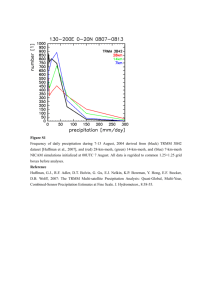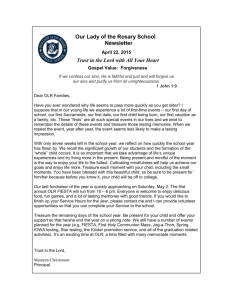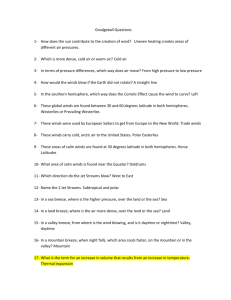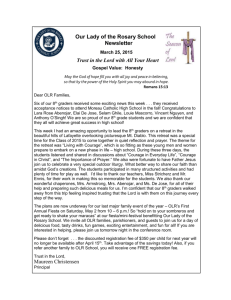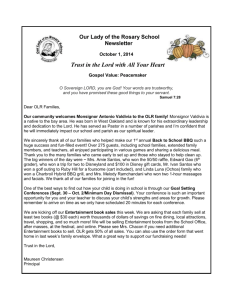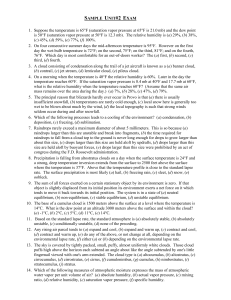Kalpana-1 & Insat 3A Product Information
advertisement
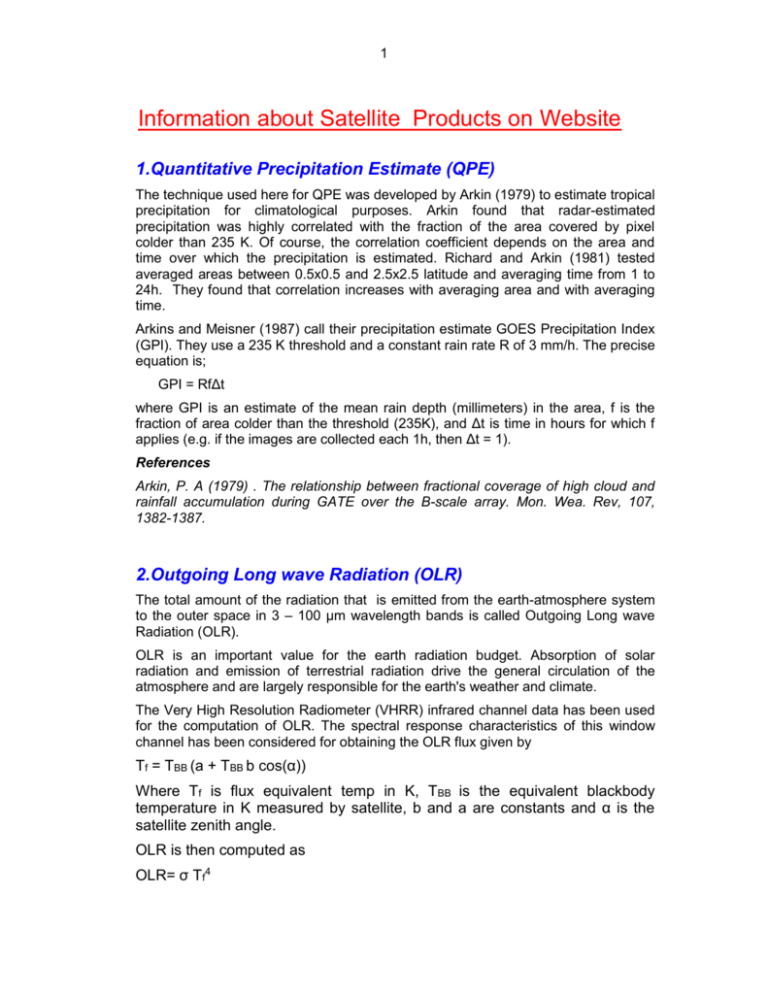
1
Information about Satellite Products on Website
1.Quantitative Precipitation Estimate (QPE)
The technique used here for QPE was developed by Arkin (1979) to estimate tropical
precipitation for climatological purposes. Arkin found that radar-estimated
precipitation was highly correlated with the fraction of the area covered by pixel
colder than 235 K. Of course, the correlation coefficient depends on the area and
time over which the precipitation is estimated. Richard and Arkin (1981) tested
averaged areas between 0.5x0.5 and 2.5x2.5 latitude and averaging time from 1 to
24h. They found that correlation increases with averaging area and with averaging
time.
Arkins and Meisner (1987) call their precipitation estimate GOES Precipitation Index
(GPI). They use a 235 K threshold and a constant rain rate R of 3 mm/h. The precise
equation is;
GPI = RfΔt
where GPI is an estimate of the mean rain depth (millimeters) in the area, f is the
fraction of area colder than the threshold (235K), and Δt is time in hours for which f
applies (e.g. if the images are collected each 1h, then Δt = 1).
References
Arkin, P. A (1979) . The relationship between fractional coverage of high cloud and
rainfall accumulation during GATE over the B-scale array. Mon. Wea. Rev, 107,
1382-1387.
2.Outgoing Long wave Radiation (OLR)
The total amount of the radiation that is emitted from the earth-atmosphere system
to the outer space in 3 – 100 µm wavelength bands is called Outgoing Long wave
Radiation (OLR).
OLR is an important value for the earth radiation budget. Absorption of solar
radiation and emission of terrestrial radiation drive the general circulation of the
atmosphere and are largely responsible for the earth's weather and climate.
The Very High Resolution Radiometer (VHRR) infrared channel data has been used
for the computation of OLR. The spectral response characteristics of this window
channel has been considered for obtaining the OLR flux given by
Tf = TBB (a + TBB b cos(α))
Where Tf is flux equivalent temp in K, TBB is the equivalent blackbody
temperature in K measured by satellite, b and a are constants and α is the
satellite zenith angle.
OLR is then computed as
OLR= σ Tf4
2
Where σ is the Stefan Boltzmann constant (Ohring et al., 1984) and . OLR
has been computed in units of Watts/m2.
References
Ohring, G., and R. G. Ellingson, 1984: Satellite determination of the
relationship between total long wave radiation flux and infrared window
radiance, J. Climate Appl. Meteor., 23, 416-425.
3.Atmospheric Motion Vectors
The Cloud Wind Motion algorithm measure the displacement of cloud patterns
between currently 3 slots of images and through this displacement computes the
wind vectors. Automatic tracking is done primarily using the cross-correlation
method. In the first of the two images, a target array of typically 20x20 pixels (defined
by the user) is selected. The problem is to locate this area in the second image,
assuming that the clouds have moved but changed little, during the time interval
between images. A search array typically 60x60 pixels (for IR) and 50x50 (for Water
Vapor) centered on the location of the target array is chosen in the second image.
The extraction process runs in two different modes. In the backward correlation
mode, one tries to locate a cloud pattern (tracers) found in the segment of a target
image in the previous image, the search image, and to derive from the displacement
of the patterns in the two images the wind speed and direction. In the forward
correlation mode, the same analysis is performed using the succeeding image as the
search image. Currently, the winds of a backward correlation are combined with the
winds of a forward correlation using the same slot as target in the two correlation
processes. The target slot is therefore the central slot of consecutive triplets of
images. Since the same target slot is used, there is no problem in identifying halfwinds belonging together, performing a consistency check on them with respect to
speed and direction and combining them into one wind. The quality of the individual
spectral winds is characterized by a set of quality indicators which are amalgamated
into a quality mark.
Several methods can be used to make the height estimate of the wind, comparison
of the equivalent blackbody temperature of the cloud top with a numerical forecast of
the vertical profile and the H2O-intercept (Nieman et al, 1997). The H2O-intercept is
predicated on the fact that the radiances from a single-level cloud deck for two
spectral bands vary linearly with cloud amount. Radiances from the infrared window
and H2O absorption bands are measured and compared to Planck body radiances
as a function of cloud top pressure. A numerical forecast of temperature and
humidity profile in the region is used for the necessary radiative transfer calculations
.Measured and calculated radiances will agree for clear sky and opaque cloud
conditions. The cloud-top height is inferred from the linear extrapolation of measured
radiances onto the calculated curve of opaque cloud radiance.
The advantage of water-vapor track winds compared to the cloud tracked winds is
that they may be estimated in areas free of clouds.
The automated quality control is based on EUMETSAT approach. For each final
wind candidate, a set of marks is computed:
-
The wind direction consistency mark.
3
-
The wind speed consistency mark.
The wind vector consistency mark.
The correlation consistency mark.
The Slot-to-Slot height consistency mark.
The spatial consistency mark.
The forecast consistency mark.
The final AQC mark is calculated from a linear combination of these marks with
different weights (user-defined) for each mark.
References
1.
(Nieman, 1997) Nieman, S.J., Meanzel, W.P., Hayden, C.M. et al., Fully Automated
Cloud-Drift Winds in NESDIS Operations, Bulletin of Am. Meteo. Soc., Vol. 78, No 6,
June, p 1122-1133.
4. Normalized Difference Vegetation Index (NDVI)
The “Normalized Difference Vegetation Index” (NDVI) is widely used for vegetation
monitoring in remote sensing. NDVI was originally used as a measure of green biomass
(Tucker et al, 1986). It has a strong theoretical basis as a measure of the solar
photosynthetic active radiation absorbed by the canopy (Sellers,1985).The NDVI relates
reflectance (or radiance) in the red range and in the NIR range to vegetation variables
such as leaf area index (LAI), canopy cover, and the concentration of the total
chlorophyll. It is sensitive to low chlorophyll contents, to low fraction of vegetation cover
4
and, as a result, to low level of absorbed photosynthetic active solar radiation. But it is
not sensitive at higher chlorophyll contents or to rate of Photosynthesis for large
vegetation coverage. For land surfaces dominated by vegetation, the NDVI values
normally range from 0.1 to 0.8 during the growth season, the higher values being
associated with greater density and greenness of the plant canopy.
Algorithm for derivation:
Step 1 : Computation of angular geometry
Step 2 : Conversion of gray count (DN) to at-sensor reflectance (Ri)
Step 3 : Elimination of cloud, snow and water body and generation of no land
mask
Step 4 : Generation of daily Rayleigh corrected and angular normalized
surface (Level 1A) reflectances (Ri_surf) for clear land pixels
Step 5 : Generation of daily NDVIcorr over clear land pixels by the following formula:
NDVI corr [nday] = ((RNIR_surf – Rred_surf)/( RNIR_surf +Rred_surf))*
(water_snow_cloud mask)*land_sea_mask
Step 6 : Generation of ten-day composite NDVI (NDVId)
References:
1. B.K. Bhattacharya, M. R. Pandya: 2007, IMDPS PR ATBD Document, 271-284
5
5. Daily Average IR Image
This is an image created by averaging the grayscale values of the IR channel for four
images (00, 06, 12,18 UTC) of a day at each pixel location and then displayed.
6. Daily average WV Image
This is an image created by averaging the grayscale values of the WV channel for four
images (00, 06, 12,18 UTC) of a day at each pixel location and then displayed.
7.
Latitude –Time Diagram of daily OLR from 1st January 2009
This image displays the daily progression of OLR (daily mean) through the latitude belt
15 S to 40 N. The OLR values are averaged over 50 E to 110 E for each latitude.
8.
Latitude–Time Diagram of daily OLR (Monsoon Season
2008)
This image displays the daily progression of OLR (daily mean) through the latitude belt
15 S to 40 N during monsoon season (01June to 30 September) of 2008. The OLR
values are averaged over 50 E to 110 E for each latitude.
9.
Maps Daily, weekly, Monthly, Seasonal Mean OLR
This image displays the OLR value averaged over a day / week / month / season over
0.25 X 0.25 grid boxes for a region 40 E to 120 E and 40 S to 40 N.
10.
Cloud Top Temperature Contours
This products indicates the contours of the Cloud top temperature of the IR channel. The
range of values for which contours are drawn is –20 to –80 deg.C. in intervals of 10
deg.C. Another image displays contours of CTT below –40 deg.C.
11. Visible Band Imagery
Imagery derived from reflected sunlight at visible wavelengths of 0.55-0.75 μm. The
ground resolution at the sub-satellite point is nominally 2 km x 2 km and in the normal
mode of operation the instrument is designed to scan 20 deg east-west covering 50
deg.N to 40 deg S latitude.
6
12. Infra-red Band Imagery
Imagery derived from emission by the Earth and its atmosphere at the thermal –infrared
wavelengths of 10.5-12.5 μm. The ground resolution at the sub-satellite point is
nominally 8 km x 8 km and in the normal mode of operation the instrument is designed
to scan 20 deg east-west covering 50 deg.N to 40 deg S latitude.
13. Water Vapor Band Imagery
Imagery derived from water vapor emissions at 5.7-7.1 μ m. The ground resolution at the
sub-satellite point is nominally 8 km x 8 km and in the normal mode of operation the
instrument is designed to scan 20 deg east-west covering 50 deg.N to 40 deg S latitude.
14. Color Composite Imagery
False Color Composite imagery created by mixing together data from one or more
satellite bands with different enhancements in the R,G,B channels. Generally IR and
Visible band data is mixed together to create an user friendly image.
15. CCD imagery
The INSAT satellite CCD payload data is received in the following wavelength bands:
(a) Visible band at 0.62–0.68 μ m,
(b) Near IR band at 0.77–0.86 μ m and
(c) Short wave IR band at 1.55–1.69 μ m.
The ground resolution at the sub-satellite point is nominally 1 km x 1 km and in the
normal mode of operation the instrument is designed to scan a 10° x 10° field of view,
which corresponds to a ground area of about 6300 x 6300 km. The image displayed, is a
false color composite image created by mixing together data from one or more satellite
bands with different enhancements.
16.
NOAA APT Visilble and IR images
The National Oceanographic and Atmospheric Administration (NOAA) of the United
States of America supports several Weather Satellites in Low Earth Orbit. Currently
these are NOAA-16, NOAA-17 and NOAA-18, all of which make descending (i.e. from
north to south) orbits during the morning.
All three satellites broadcast using a system termed Automatic Picture Transmission
(APT) in which they scan the Earth, 840 kilometers beneath them, continuously. This
results in images that build up line by line, rather like the image on a TV screen.
However, a complete APT image takes 12 to 14 minutes to build up at a rate of two lines
per second. These transmissions are received on frequencies in the 137MHz band.
7
A typical NOAA satellite APT image consists of two frames, one in visible wavelengths;
and the other imaged in infrared. These images are transmitted as greyscale images
(i.e. no colour). and have resolution of 4X4Km. in Visible as well as in Infra Red bands.
17. GPS Precipitable Water vapour data:
Ground based GPS systems are used for the estimation of Integrated Precipitable water
vapour (IPWV). It is measured by computing the delay in GPS signals due to the
moisture present in the atmosphere. The main sources of delay in GPS dual frequency
radio signals (L1=1575 Mhz, L2=1225 Mhz) are Ionosphere and Troposphere. The
Ionosphere delay or error is removed by the linear combination of L1 and L2
frequencies. But Troposphere delay cannot be removed easily. The total delay in the
Zenith direction is estimated with the help of GPS observational data. The total delay in
zenith direction (ZTD) is the sum of two parts; dry delay in zenith direction called zenith
hydrostatic delay (ZHD) and wet delay, which is known as zenith wet delay (ZWD). ZTD
values are estimated from the observation file getting from the GPS receiver of each site
by measuring the pseudo range or phase delay methods .The brief computation
procedure of estimation of Integrated Precipitable Water Vapour (IPWV) is given below:
ZTD ZHD ZWD
ZHD values are more sensitive to station level pressure and temperature and calculated
by the following formula:
ZHD 0.00278 * Ps *{1 0.0026 * cos(2 ) 0.00000028 * H s }
Where, Ps =Station level pressure in milibar
Hs = Surface height above geoid in Km
= Latitude of the station
PWV K * ZWD
Where,
8
K {10 6 (
k3
k '2 ) Rv }1
Tm
= Density of water in Kg/m
PWV from ZTD cont.
3
Where,
k
'
2
(17 10) Kmb 1 , k3 (3.776 0.004)105 K 2 mb 1
RV = water vapour gas constant
Tm = weighed mean temperature of the atmosphere is given by
Tm 55.8( 0 K ) 0.77 * Ts ( 0 K )
Ts = Surface temperature
ZHD values can be modeled properly and ZWD values cannot be modeled properly due
to its in homogeneity in space and time. The final output product of precipitable water will
be in mm. Its estimation from GPS is more precise and timely which is very useful in
assimilating it into numerical models to modify the moisture fields.
18. Upper Tropospheric Humidity
Upper Tropospheric Humidity (UTH) is an estimate of the mean relative humidity of the
atmosphere between approximately 600 hPa and 300 hPa. UTH is basically a measure
of weighted mean of relative humidity according to the weighting function of the water
vapor channel. Therefore, UTH is more likely a representative of the relative humidity
around the atmospheric layer where weighting function of water vapor channel peaks.
The UTH estimation is in principle the computation of weighted mean column values of
the upper tropospheric relative humidity. It involves quantitative description of the
transfer of radiation by radiative transfer model in the water vapor channel from the
surface to the satellite sensor through atmosphere. The transfer calculations are
performed for a set of different constant humidity values for the upper tropospheric
atmosphere for standard atmosphere. Since geostationary satellites are located over
equator, we have used standard tropical atmosphere to represent the vertical
temperature structure.
References:
1. R Singh, PK Thapliyal and Shivani Shah : 2007, IMDPS PR ATBD Document,178-190
2. P K Thapliyal, M Vinayak, K S Ajil, S Shah, P K Pal and P C Joshi : Estimation of Upper
Tropospheric Humidity from water vapour channel of Very High Resolution Radiometer onboard
INSAT-3A and Kalpana Satellites, SPIE, pp 1-7
9
19. Sea Surface Temperature
Sea surface temperature has been derived from a single thermal window channel (10.512.5 μm) over cloud free oceanic regions. The most important part of the SST retrieval
from IR observations is the atmospheric correction. Retrieval of sea surface temperature
(SST) from thermal infrared window channels (10- 12 um) requires atmospheric
corrections arising due to attenuation of signal by intervening moisture. This correction is
more in tropics due to higher amount of atmospheric moisture. The algorithm for SST
retrieval using single thermal window channel of KALPANA and total water vapor
content has been developed using radiative transfer simulations for Indian tropical
marine conditions. In absence of a suitable channel for total water vapor estimation in
KALPANA, the atmospheric correction is being carried out by using total water vapor
fields from TRMM/TMI. Accordingly, based on radiative transfer simulations, water vapor
dependent SST retrieval coefficients have been developed.
References:
1. Aloke K Mathur and Neeraj Agarwal: 2007, IMDPS PR ATBD Document, 68-77
2. Aloke K Mathur, Neeraj Agarwal, Naveen Shahi and Abhijit Sarkar: Impact of water vapour
fields on sea surface temperature retrievals from KALPANA data:, 1-10
------------------------------------------------------------------------------------------------------------
